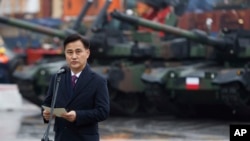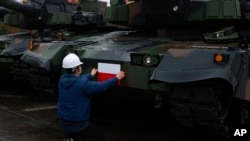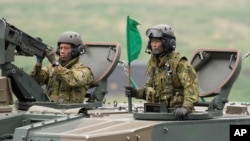Until last year, many countries in Western Europe had long-standing policies against sending weapons into war zones. Russia’s invasion of Ukraine quickly changed all that.
Those countries — most notably Germany, Sweden, and Norway — changed course, eventually donating several rounds of arms to help Ukraine fight a battle they see as decisive for Europe’s future.
But after nearly a year of fighting, and with Europe now struggling to produce enough ammunition for Ukraine and itself, the search is on for other sources of weapons.
Some are looking to Northeast Asia for help. During a trip this week that included stops in Seoul and Tokyo, NATO Secretary General Jens Stoltenberg called for more military aid to Ukraine, noting the example set by European countries.
“After the brutal invasion of Ukraine, these countries changed their policy,” Stoltenberg said during an address in Seoul. “If you don’t want autocracy and tyranny to win, then they need weapons. That’s the reality.”
South Korea and Japan have already given Ukraine non-lethal military gear, such as bulletproof vests and helmets. But neither country has sent weapons directly to Ukraine, in part because of the same types of legal restrictions that had limited many European countries.
Neither South Korea nor Japan have given any indication they will change their policies toward Ukraine, but Stoltenberg’s comments suggest both countries may come under more Western pressure to provide military support, especially as the war grinds on.
South Korea circuitous approach
So far, South Korea has only indirectly supported Ukraine’s war effort. Instead of donating weapons, South Korea’s government has approved the sale of South Korean-made arms to countries that are supplying the Ukrainian military.
Poland, a major arms supplier for Ukraine, last year agreed to purchase $5.8 billion in South Korean weapons, including tanks, howitzers, and ammunition. South Korean companies have inked smaller deals with Estonia and Norway, and are in similar talks with the United States and Canada.
“These are being used to replace older weapons being sent by these countries to Ukraine, and there are credible reports that some of them will make their way to Ukraine, or are already getting there,” said Ramon Pacheco Pardo, a Korea specialist at King’s College London.
South Korean officials have not announced any policy to enable the direct provision of weapons, though their language on the issue appears to be softening.
Asked Tuesday whether Seoul was considering arms exports to Ukraine, South Korean defense minister Lee Jong-sup said he and the NATO chief “share the same sentiment on the need for the international effort” in resolving the crisis.
During his meeting with Stoltenberg, South Korean President Yoon Suk Yeol mentioned a “possible role in cooperation with the international community to help the Ukrainian people,” but did not elaborate, according to a statement released by the South Korean presidential office.
Some foreign news reports saw those comments as a sign Seoul is open to changing its mind.
But a Seoul-based diplomat from a NATO country told VOA he did not expect a major shift from South Korea anytime soon, given Seoul’s close economic ties with Russia, as well as Moscow’s influence with North Korea.
“I hope I’m wrong,” said the diplomat, who was not authorized to speak to the media.
Even with indirect South Korean support for Ukraine, Russia still is not happy. In March, Moscow placed Seoul on a list of “unfriendly” nations. In October, Russian President Vladimir Putin warned South Korea providing arms to Ukraine “will destroy our relations.”
Japan’s arms restrictions
There may be even less chance that Japan sends weapons to Ukraine.
Though Japan is gradually loosening its pacifist restraints, its legal restrictions on arms exports appear less flexible than those in South Korea.
Despite those barriers, Japan has become one of Ukraine’s staunchest supporters. It quickly joined Western sanctions against Russia, sent over a billion dollars in financial and humanitarian aid to Ukraine and its neighbors, and even delivered non-lethal military equipment to Ukraine — a step that until recently was unthinkable.
“We now have a situation where Ukrainian soldiers on the frontlines are wearing Japanese Type 88 helmets and using Japanese drones as they fight and kill soldiers from a country neighboring Japan,” said Jeffrey J. Hall, who teaches at Japan’s Kanda University of International Studies.
Russia’s invasion came as a major shock in Japan, which like Ukraine has threatening neighbors with nuclear weapons. As a result, the Japanese public broadly supports the government’s approach to Ukraine, opinion polls suggest.
“But handing the Ukrainians the tools to directly kill Russians, such as ammunition, would be much more controversial,” said Hall.
Japanese Prime Minister Fumio Kishida also may have other priorities. Perhaps most notably, he must find a way to pay for a plan to double defense spending over the next five years without relying too heavily on unpopular tax hikes.
“This puts Kishida in a politically shaky situation where he will want to avoid introducing any further policy changes that could hurt his approval ratings,” Hall added.
Even if Japan eventually gave weapons to Ukraine, its potential impact may be less than that of South Korea, which has a much larger defense export industry.
Continued pressure?
As long as the war in Ukraine continues — and keeps sapping Western countries of their ammunition stockpiles — South Korea and Japan may face continued pressure to arm Ukraine.
That’s especially the case since both countries are led by conservative governments that have attempted to further align themselves with the West and deepen ties with NATO.
During his visits this week, Stoltenberg vowed closer ties with Japan and South Korea. While he expressed reluctance to offer specific policy advice, he warned that the security of Europe and Asia are connected.
“We must keep supporting Ukraine, for as long as it takes,” he said. “Because if President Putin wins, the message to him and other authoritarian leaders will be that they can get what they want through the use of force.”









